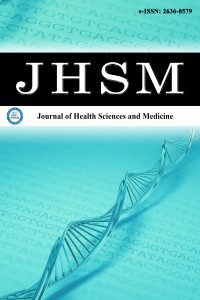Distribution of bacteria isolated from urine cultures and resistance pattern of Escherichia coli strains in community-acquired urinary tract infections
Distribution of bacteria isolated from urine cultures and resistance pattern of Escherichia coli strains in community-acquired urinary tract infections
resistance community acquired, urinary tract infection,
___
- Gupta K, Hooton TM, Naber KG, et al. International clinical practice guidelines for the treatment of acute uncomplicated cystitis and pyelonephritis in women: a 2010 update by the Infectious Diseases Society of America and the European Society for Microbiology and Infectious Diseases. Clin Infect Dis. 2011;52(5):e103-e120.
- Foxman B. Epidemiology of urinary tract infections: incidence, morbidity, and economic costs. Am J Med. 2002;113(1):5-13.
- Demirtürk N, Demirdal T, Eldemir H, İnce R, Altındiş M. İdrar örneklerinden izole edilen bakterilerin antibiyotiklere duyarlılıkları. Türk Mikrobiyol Cem Derg. 2005;35(2):103-106.
- Foxman B. Urinary tract infection syndromes: occurrence, recurrence, bacteriology, risk factors, and disease burden. Infect Dis Clin. 2014;28(1):1-13.
- Griebling TL. Urologic diseases in America project: trends in resource use for urinary tract infections in women. J Urol. 2005;173(4):1281-1287.
- Karlowsky JA, Kelly LJ, Thornsberry C, Jones ME, Sahm DF. Trends in antimicrobial resistance among urinary tract infection isolates of Escherichia coli from female outpatients in the United States. Antimicrob Agents Chemother. 2002;46(8):2540-2545.
- Ronald A. The etiology of urinary tract infection: traditional and emerging pathogens. Am J Med. 2002;113(1):14-19.
- Laxminarayan R, Duse A, Wattal C, et al. Antibiotic resistance—the need for global solutions. Lancet Infect Dis. 2013;13(12):1057-1098.
- Akay H, Duranay M, Akay A. Üriner sistem enfeksiyonlarından izole edilen mikroorganizmaların dağılımı ve Escherichia coli suşlarında antibiyotik duyarlılığı. İstanbul Tıp Fakültesi Derg. 2006;69(1):1-4.
- Colgan R, Williams M, Johnson JR. Diagnosis and treatment of acute pyelonephritis in women. Am Fam Physician. 2011;84(5):519-526.
- Wayne P. National committee for clinical laboratory standards. Performance standards for antimicrobial disc susceptibility testing. 2002;12:01-53.
- Gözüküçük R, Çakıroğlu B, Nas Y. Toplum kaynaklı üriner sistem enfeksiyonu etkeni olarak saptanan Escherichia coli izolatlarının antibiyotik duyarlılıkları. JAREM. 2012;2(3):101-103.
- Ranjan Dash N, Albataineh MT, Alhourani N, et al. Community-acquired urinary tract infections due to extended-spectrum β -lactamase-producing organisms in United Arab Emirates. Travel Med Infect Dis. 2018;22:46-50. doi:10.1016/j.tmaid.2018.01.007
- Dunne MW, Puttagunta S, Aronin SI, Brossette S, Murray J, Gupta V. Impact of empirical antibiotic therapy on outcomes of outpatient urinary tract infection due to nonsusceptible enterobacterales. Microbiol Spectr. 2022;10(1):e0235921.
- Tanrıverdi-Çaycı Y, Güney DB, Ertokatlı M, Hacıeminoğlu-Ülker K, Birinci A. Prevalence of fosfomycin resistance among enterobacterales isolates in a tertiary care hospital from Turkey. Infect Dis Clin Microbiol. 2022;4(4):252-257.
- Rock W, Colodner R, Chazan B, Elias M, Raz R. Ten years surveillance of antimicrobial susceptibility of community-acquired Escherichia coli and other uropathogens in northern Israel (1995-2005). Isr Med Assoc J. 2007;9(11):803-805.
- Yılmaz N, Ağuş N, Bayram A, et al. Antimicrobial susceptibilities of Escherichia coli isolates as agents of community-acquired urinary tract infection (2008–2014). Turk J Urol. 2016;42(1):32.
- Sağlam HS, Demiray V, Karabay O. Üriner enfeksiyonlarda toplum kökenli Escherichia coli'n in yeri ve gelişen antibiyotik direnci. Nobel Medicus J. 2012;8(1).
- Schaeffer AJ. The expanding role of fluoroquinolones. Am J Med. 2002;113(1):45-54.
- Goettsch W, Van Pelt W, Nagelkerke N, et al. Increasing resistance to fluoroquinolones in Escherichia coli from urinary tract infections in the Netherlands. J Antimicrob Chemother. 2000;46(2):223-228.
- Taşbakan Mi, Pullukçu H, Yamazhan T, Arda B, Ulusoy S. Toplum kökenli üriner sistem infeksiyonlarindan soyutlanan Escherichia coli suşlarina fosfomisinin in-vitro etkinliğinin diğer antibiyotiklerle karşilaştirilmasi. Ankem Derg. 2004;18(4):216-219.
- Coşkun B, Ayhan M. Toplum kökenli alt üriner sistem enfeksiyonlarının değerlendirilmesi. J Ankara University Faculty of Medicine/Ankara Üniversitesi Tip Fakültesi Mecmuasi. 2022;75(3).
- Caskurlu H, Culpan M, Erol B, Turan T, Vahaboglu H, Caskurlu T. Changes in antimicrobial resistance of urinary tract infections in adult patients over a 5-year period. Urologia Internationalis. 2020;104(3-4):287-292.
- Pullukçu H, Aydemir Ş, Taşbakan MI, Sipahi OR, Çilli F, Ulusoy S. Nitrofurantoinin idrar kültürlerinden soyutlanan Escherichia coli suşlarına in vitro etkinliği. İnfeksiyon Derg. 2007;21(4):197-200.
- Baylan O. Fosfomisin: dünü, bugünü ve geleceği. Mikrobiyoloji Bülteni. 2010;44(2):311-321.
- Kurt Ö, Güneş H, Gümüş A, Mutlu R, Topkaya AE. Toplumsal kaynaklı üriner sistem infeksiyonlarından izole edilen Escherichia coli suşlarında fosfomisin, nitrofurantoin ve siprofloksasinin in-vitro etkinliği. ANKEM Derg. 2014;28(2):58-62.
- Yayın Aralığı: Yılda 6 Sayı
- Başlangıç: 2018
- Yayıncı: MediHealth Academy Yayıncılık
Reappraisal of the role of Helicobacter pylori in chronic spontaneous urticaria
Sinem ÖRNEK ÖZDEMİR, Emek ÖZGÜR
Impact of the COVID-19 pandemic on mode of delivery
Elif GÜNDOĞDU, Elif ÜNLÜGEDİK SAYIN, Medine KAHRAMAN KAYA
Biriz ÇAKIR, Fatma NİŞANCI KILINÇ, Emine Merve EKİCİ, Çiler ÖZENİR
Exploring occupational safety and health in future workscapes
Eyüp ÖZKAN, Yücel YILMAZ, Fatma Betül ÇELİK, Şaban KELEŞOĞLU, Yasemin DOĞAN, Erkan DEMİRCİ, Esen KASAPOĞLU, Ümmühan Zeynep BİLGİLİ, Mustafa CALISKAN
Pınar AKDUR, Nazan ÇİLEDAĞ, Burcu SAVRAN, Ayşe OCAK DURAN
Dilek BULUT, Hanife Nur KARAKOÇ
Utilizing the MRI findings to diagnose acute appendicitis in pregnant women
